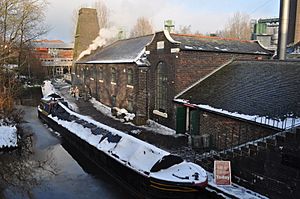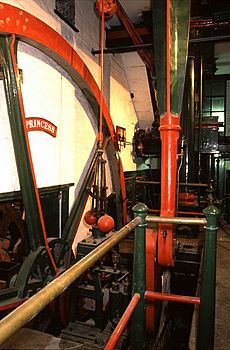Etruria Industrial Museum facts for kids
 |
|
| Lua error in Module:Location_map at line 420: attempt to index field 'wikibase' (a nil value). | |
| Established | 1991 |
|---|---|
| Location | Lower Bedford Street Etruria, Staffordshire, England |
| Type | Industry |
The Etruria Industrial Museum is in Etruria, Staffordshire, England. It is a great example of an old factory from the 1800s. This factory used steam power to grind materials for making pottery. The museum is located right between the Trent and Mersey Canal and the special staircase locks of the Caldon Canal.
The museum has a new entrance building. This leads into the old factory, which is a very important historic building. It used to be called the Etruscan bone and flint mill. This mill is also protected as a "scheduled monument," meaning it's a really important historical site.
Contents
History of the Mill
This factory, known as the bone and flint mill, was built in 1857. Its main job was to grind materials like bone and flint. These ground materials were then used by local pottery makers. The mill was run by the same family for many years, until 1975. It was common for factories like this to be built next to canals. Canals were like the highways of the past, used to transport goods. Another example of a mill by a canal is the Cheddleton Flint Mill.
Bringing the Museum Back to Life
The Etruria Industrial Museum site was officially recognized as a heritage site in the 1970s. It was first called an "ancient monument." A big project to restore the mill began in 1978. After a lot of hard work, the museum officially opened in 1991. The famous TV presenter Fred Dibnah helped open it.
Inside the museum, visitors can learn all about the mill's history. They can also see the old machines that were used. One of the most exciting things is a working steam engine called "Princess." This engine is very old, dating back to the 1820s. It was already second-hand when the mill was built! There is also a working blacksmith's forge near the museum's entrance. More restoration work was done in the mid-1980s. This was part of getting ready for the big national Stoke-on-Trent Garden Festival.
Visiting the Museum Today
As of 2025, volunteers run the museum. They are part of a group called Shirley's Bone and Flint Mill Volunteer group. The museum is also part of the Stoke-on-Trent City Council’s Museum Service. Because it's run by volunteers, the museum is open to the public only on certain days throughout the year.
The museum's website shares the special days when the 1903 coal-fired boiler is fired up. This boiler creates steam to power "Princess," the old steam engine. When "Princess" runs, it turns the big grinding machinery, just like it did long ago!
In September 2015, the mill was bought by the Shirley's Bone and Flint Mill Volunteers CIO. They continue to lease it to Stoke-on-Trent City Council. This ensures the Etruria Industrial Museum remains a key part of the area's history.
The Area Around the Museum
The Trent and Mersey Canal runs through the city. The area around the canal is a special "Conservation Area." This means it's protected because of its historical importance. The Etruria section, where the mill is, is very important for urban heritage. Several other historic sites are right next to the mill:
- The staircase locks of the Caldon Canal. Many people on narrowboat holidays use these locks to travel to the town of Leek.
- A large grassy area with trees. This marks where the first gas-holder for the city once stood. It supplied heat and light to the city long ago.
- The site of the Old Dispensary and House of Recovery. This was the city's very first hospital.
It can be a bit tricky for cars to get to the museum because of weight limits on the canal bridges. There's no through-traffic, which makes the large, park-like area around the mill very nice. It's a popular spot for people living in Etruria. The Etruria Canals Festival usually happens every year at the museum. It's typically on the first weekend in June. Sometimes, the large outdoor market isn't set up by the committee.
See also


